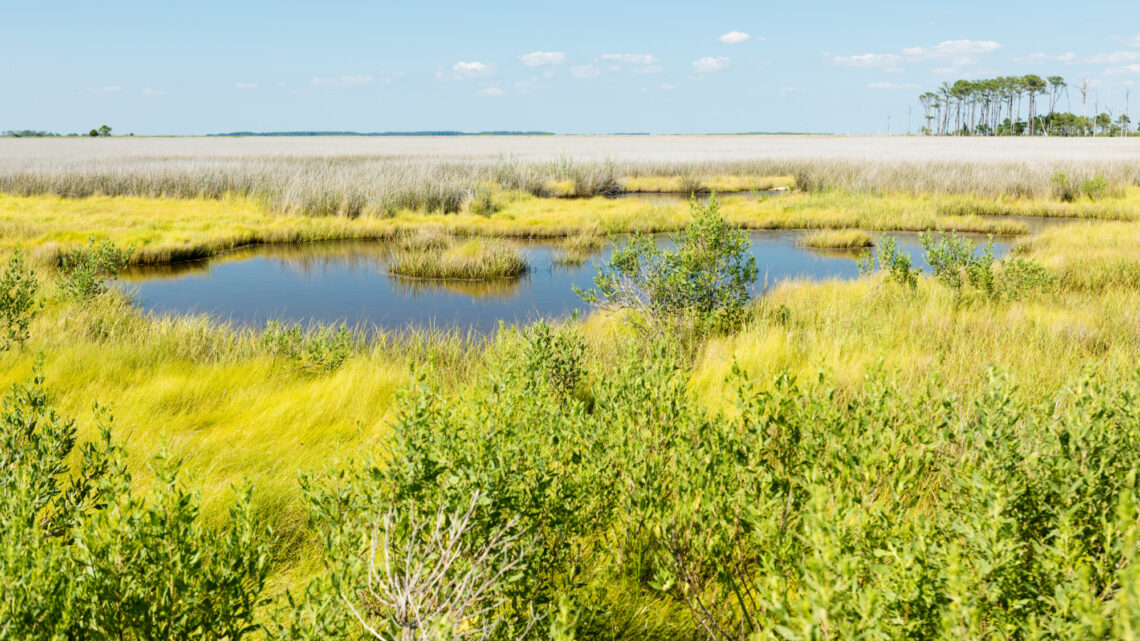Wetlands

Wetlands act as sponges, soaking up stormwater and trapping polluted runoff while providing habitat to a variety of wildlife. The gradual release of water from wetlands minimizes erosion and slows the flow of stormwater into rivers, streams and other waterways. Wetland plants filter and absorb nutrients, sediment and chemical contaminants before these pollutants can flow to nearby waterways.
Wetlands are especially important in our cities, towns and suburbs, where development and impervious surfaces (surfaces that do not absorb water like cement) drastically increase the rate and volume of polluted stormwater runoff. Unfortunately, over the past 50 years, the Chesapeake Bay watershed has lost at least 50% of its wetlands to development, sea level rise and invasive species.
Connecting to Issue Investigation
The variety of environmental benefits a wetland provides can make this solution relevant to many different investigations. For example, if during the course of an investigation or school audit, students see a need for protecting or improving wildlife habitat, decreasing impervious surfaces, cleaning runoff, or responding to flooding then a wetland can help! In addition, a school or nearby wetland can provide a fascinating outdoor laboratory and location for outdoor learning across many disciplines.
For those working towards green school awards, this action can reduce a school’s environmental impact if the wetland is located on school grounds.
Facilitating Student Action
Students should continue to have opportunities to share ideas and opinions throughout the process of identifying, planning, and implementing action. Listed here are just a few ways students can stay engaged while working on this solution—but there are many more! The complexity of each activity/task can be adjusted for each grade level.
Protect - students can educate others on why wetlands should be protected. Younger students can create simple scripts to deliver to decision makers and land owners and older students can create more involved presentations that include primary sources.
Restore - students can work on restoring a local wetland. Using age-appropriate resources, students can identify invasive plants, remove them, and suggest replacements to improve the habitat.
Create - students can create a wetland on the schoolyard or in the community. Depending on age, students can help with or lead the initial steps of determining if a wetland would thrive in a place by measuring the soil and precipitation. Students can research the components of a healthy wetland habitat and get involved with plant selection, habitat design and installation. Students can also get involved with a wetland project already underway; the local Ducks Unlimited or Conservation District may be able to help identify current projects.
Monitor - students can monitor a new or established wetland. Monitoring protocols will differ by age. Results and observations can be shared with others to encourage protection or inform restoration. Data sets can build up over years and students can track changes in the wetland.
Share and Celebrate - students can share their work with the school community by giving tours of the wetland, giving presentations, creating displays, or writing and delivering morning announcements. Students can also write articles, press releases or invite reporters from the school paper and the local newspaper.
Wetlands Resources
U.S. Fish & Wildlife Service’s Schoolyard Habitat Project Guide is a comprehensive guide that walks you through the entire process of creating or restoring a schoolyard habitat or outdoor classroom space. The information is transferable to habitats outside schoolyards. See Appendix C of the guide for wetland-specific instructions. The guide also includes ideas for monitoring and sharing the wetland.
The Wetlands Pathway from the National Wildlife Federation Eco-Schools program is a great resource to start with. The pathway includes wetland audits for different grades to guide you through the process of discovering the characteristics and health of a local wetland.
